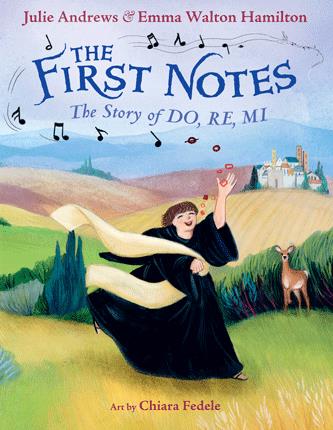| First notes : the story of do, re, mi Author: Andrews, Julie | ||
| Price: $23.78 | ||
Summary:
Guido, an Italian monk, invents a method of notating music, but is discouraged by the other monks until he is given the opportunity to share his invention and love of music. Includes information on the song "Do-Re-Mi," a glossary, and Guido's life at Pomposa Abbey.
| Added Entry - Personal Name: | Hamilton, Emma Walton |
| Illustrator: | Fedele, Chiara |
Video Preview:
Reviews:
Kirkus Reviews (+) (09/15/22)
School Library Journal (02/24/23)
Full Text Reviews:
School Library Journal - 02/24/2023 Gr 1–3—Economically recapping the story of the musical monk, Guido, who came to realize that there were just six (then seven) notes that comprised all of music, and therefore all the hymns that previously had seemed impossible to teach and learn, Andrews and Hamilton have room to include the lyrics to "Do-Re-Mi," a tribute to Rogers and Hammerstein, and a glossary. It's best to just tumble along with the storytelling, which goes between invented moments ("His heart beat faster as he drew lines between and through the marks, as if they were climbing a ladder,") and supposition ("Guido surely would have forgiven them—grateful to have realized his dream of teaching music and to have made its joys easier for people to learn"). What the authors create is a basis for explaining how the musical code was cracked and then made available to everyone by the monk's discovery. The scenes of the Italian countryside are gentle and help place this historically for young readers. VERDICT An enjoyable glimpse of history delivered with a spoonful of sugar, and why not?—Kimberly Olson Fakih - Copyright 2023 Publishers Weekly, Library Journal and/or School Library Journal used with permission.
School Library Journal - 02/24/2023 Gr 1–3—Economically recapping the story of the musical monk, Guido, who came to realize that there were just six (then seven) notes that comprised all of music, and therefore all the hymns that previously had seemed impossible to teach and learn, Andrews and Hamilton have room to include the lyrics to "Do-Re-Mi," a tribute to Rogers and Hammerstein, and a glossary. It's best to just tumble along with the storytelling, which goes between invented moments ("His heart beat faster as he drew lines between and through the marks, as if they were climbing a ladder,") and supposition ("Guido surely would have forgiven them—grateful to have realized his dream of teaching music and to have made its joys easier for people to learn"). What the authors create is a basis for explaining how the musical code was cracked and then made available to everyone by the monk's discovery. The scenes of the Italian countryside are gentle and help place this historically for young readers. VERDICT An enjoyable glimpse of history delivered with a spoonful of sugar, and why not?—Kimberly Olson Fakih - Copyright 2023 Publishers Weekly, Library Journal and/or School Library Journal used with permission.
School Library Journal - 02/24/2023 Gr 1–3—Economically recapping the story of the musical monk, Guido, who came to realize that there were just six (then seven) notes that comprised all of music, and therefore all the hymns that previously had seemed impossible to teach and learn, Andrews and Hamilton have room to include the lyrics to "Do-Re-Mi," a tribute to Rogers and Hammerstein, and a glossary. It's best to just tumble along with the storytelling, which goes between invented moments ("His heart beat faster as he drew lines between and through the marks, as if they were climbing a ladder,") and supposition ("Guido surely would have forgiven them—grateful to have realized his dream of teaching music and to have made its joys easier for people to learn"). What the authors create is a basis for explaining how the musical code was cracked and then made available to everyone by the monk's discovery. The scenes of the Italian countryside are gentle and help place this historically for young readers. VERDICT An enjoyable glimpse of history delivered with a spoonful of sugar, and why not?—Kimberly Olson Fakih - Copyright 2023 Publishers Weekly, Library Journal and/or School Library Journal used with permission.



